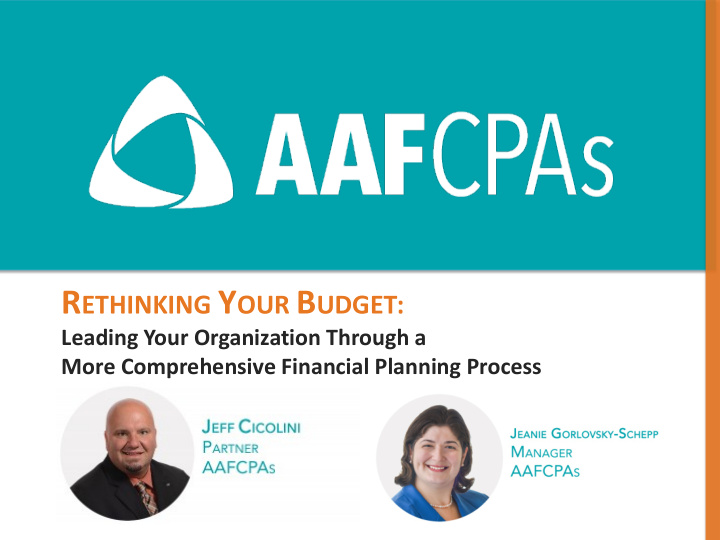



R ETHINKING Y OUR B UDGET: Leading Your Organization Through a More Comprehensive Financial Planning Process
Slides Available Now! Slides from Today’s Workshop are available at: http://info.aafcpa.com/mnn-budgeting- workshop-2017
“State of the Sector” Survey • 47% NFPs survey respondents ended the year with a surplus • 13% ended with an unplanned deficit • 53% had 3 months or less of cash on hand • 32% said their top challenge was pursuing long-term financial sustainability. Source: Nonprofit Finance Fund’s “State of the Sector” NFP Survey
The solution to these challenges must include strategic financial planning and budgeting!
Budgeting Strategically Budget to support your vision. NFPs have to balance their “business reality” with their community purpose/mission You still need to make a profit/build reserves – to “give your surplus a purpose” Many donors don’t want to fund NFPs who are in a weak financial position and have no reserves NFPs also want some independence from funders
Three Budgets All Businesses Should Have • Operating • Cash flow • Capital Businesses should have all three, and think about each strategically.
Operating Budget
Operating Budget Budgeting Strategically This is a financial reflection of your program plan. What are you going to do, and solve in your programs? What goals do you want to achieve, and how much is it going to cost? A budget allows for best use of limited resources. A budget “tells the story.”
Operating Budget Budgeting Strategically First – Step back and assess your financial position and your “baseline” How can we make our financial picture look better? What are our funders seeing?
Operating Budget Budgeting Strategically Look at key ratios and trends over the last 3-5 years, such as: Operating results (“profits”) as a percentage of operating revenue Level of operating reserves (without property and equipment, Board-designated, and donor-restricted net assets) What is the number of months of operating expenses, excluding depreciation, in operating reserves? Trends in operating results, reserves over time Liquidity – such as current ratio, cash trends, collectability of receivables Leverage – such as debt/equity ratio
Operating Budget Budgeting Strategically If past trends continue, what will the impact be? Determine if any trends need to be “corrected,” and make this part of the financial plan.
Operating Budget Budgeting Strategically Second - Look at each program/activity Communication is key! Program, finance departments need to be “thought partners,” and consider program nuances and future changes.
Operating Budget Budgeting Strategically Which are “core” mission programs? How are programs performing financially? How can we improve performance? Which are covering direct costs? Which are contributing to overhead? Will proposed new program(s) fit within our core mission, and what’s the financial impact? Can we afford it?
Operating Budget Budgeting Strategically Look at overhead, infrastructure costs (IT upgrades, staff development, etc.) Avoid the “nonprofit starvation cycle” of never having enough to invest resources in infrastructure Is our overhead “too lean?”
Operating Budget Budgeting Strategically Understand revenue concentrations and related risks: What is the right “mix” of revenue for you? Understand “fixed” costs, obligations (such as leases) Identify “risks,” and what you can do to mitigate them A good budget needs to be “real.”
Operating Budget Budgeting Strategically Then – Develop short and long- term financial plans that align with your strategic plan, and put the plans into action! 3-5 year financial plan • and budget
Operating Budget Budgeting Strategically Best Practice : 3-5% “profit” annually to grow operating reserves. How much of a safety net do we need?
Operating Budget Budgeting Strategically What strategies do we need to incorporate into our financial plans to meet our short and long-term goals? Think about building different types of reserves, such as working capital/operating, stability funds, program expansion reserves, innovation funds.
Operating Budget Budgeting Strategically Closely monitor actual results, and communicate with program staff & development. Is the financial plan viable?
Operating Budget Budgeting Strategically Compare budget-to-actual, YTD results monthly. Always refer back to your original budget. Avoid reforecasting. Once budget is established, work within the plan. As needed, ask: Why do results differ from the plan?
Cash Flow Budget
Cash Flow Budget How does your operating budget match up to your cash flow needs? Consider timing differences. When is cash coming in/going out? Need to have a cash management plan to keep you solvent all year long.
Cash Flow Budget Look at key cash flow ratios, trends over the last 3-5 years (e.g. cash trends, # months of expenses in operating cash) Best Practice: 3-6 months of unrestricted current assets on hand
Capital Budget
Capital Budget What are your future capital needs, and how are you going to pay for them? Capital expenditures can quickly wipe out reserves What needs are an “immediate” priority? Consider capital “sources” and “uses” Consider a capital needs study…
Capital Budget It’s important to “cover” depreciation expense as part of your operating budget It can also be important to build a capital reserve
Budgeting Strategically Integrate all 3 budgets together
Ask Yourself… Do we ask for funding that covers full costs of programs? Are we budgeting to build surpluses? Can we collaborate with other NFPs to increase our operational efficiency?
Ask Yourself… Do we have the financial adaptability necessary to implement the growth or change that we are pursuing? Can we influence policy to improve our funding?
Helpful Resources National Center for Charitable Statistics – Operating Reserve Policy Toolkit for Nonprofit Organizations http://www.nccs2.org/wiki/images/d/df/O perating_Reserves_Policy_Toolkit_1st_ED_2 011-07-28.pdf The Wallace Foundation – Resources for Nonprofit Financial Management http://www.wallacefoundation.org/knowle dge-center/Resources-for-Financial- Management/Pages/Planning.aspx
Helpful Resources Best Practices in Managing Your Nonprofit Operating Budget | AAFCPAs https://www.aafcpa.com/2017/07/03/b est-practices-managing-nonprofit- operating-budget/ AAFCPAs’ Podcast Series Recorded LIVE at our Nonprofit Educational Seminar, May 2017 https://www.aafcpa.com/podcasts/
Questions & Comments Jeff Cicolini, CPA, CGMA 774.512.4026 jcicolini@aafcpa.com Jeanie Gorlovsky-Schepp, CPA 774.512.4000 jgorlovsky-schepp@aafcpa.com
Recommend
More recommend